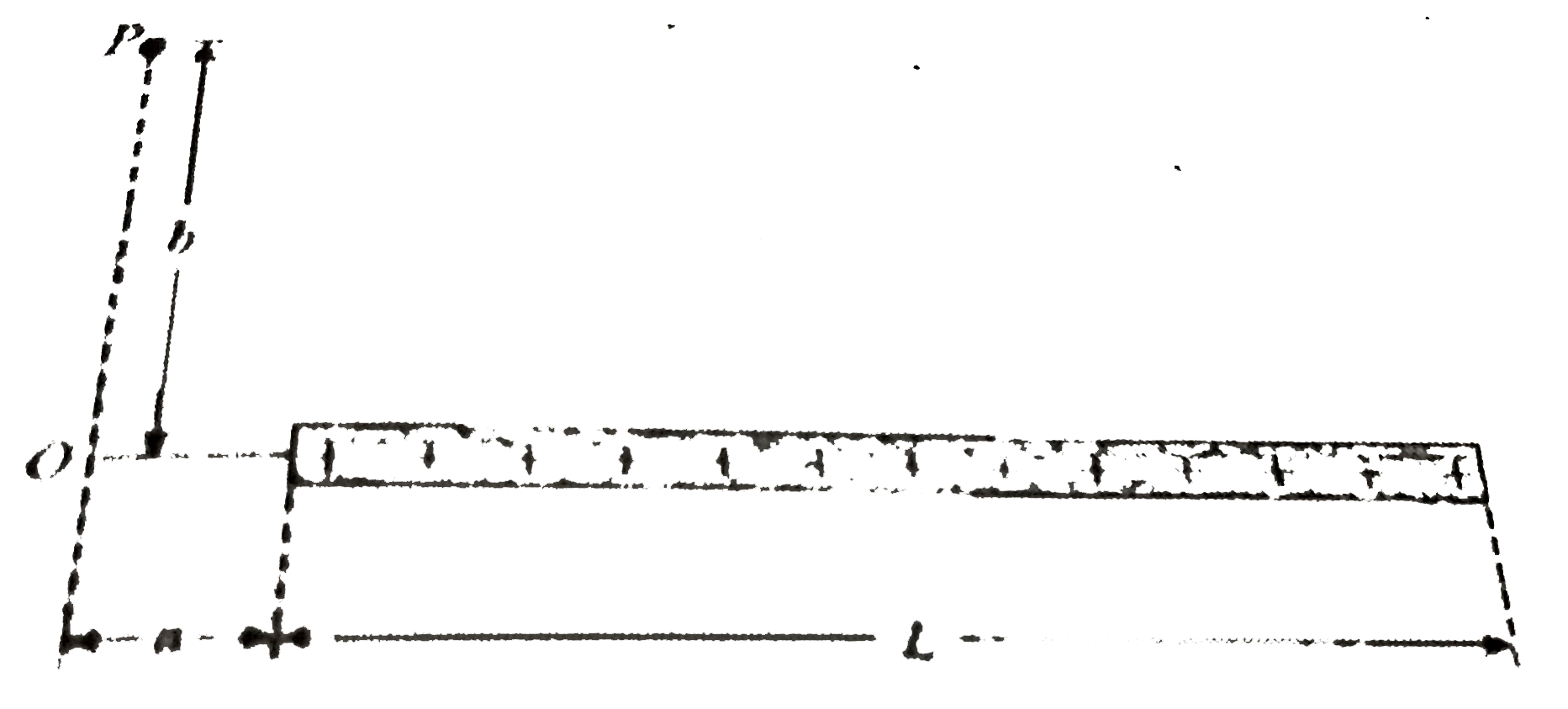A positively charged rod lies along X-axis in such a manner that one end of the rod is at the origin and the other end at x=−∞. The linear charge density for the rod is λ. Electric field intensity at x =a is
λ4πε0aˆi
−λ4πε0aˆi
λ4πε0a2ˆi
−λ4πε0a2ˆi
The correct Answer is:A
To find the electric field intensity at point x=a due to a positively charged rod lying along the negative x-axis, we can follow these steps:
Step 1: Understand the Configuration
The rod is positioned along the x-axis from the origin (0,0) to x=−∞. The linear charge density of the rod is given as λ.
Step 2: Define a Small Charge Element
Consider a small element of the rod at position x with a length dx. The charge dq on this small element can be expressed as:
dq=λdx
Step 3: Determine the Distance to the Point of Interest
The point where we want to calculate the electric field is at x=a. The distance from the charge element at position x to the point x=a is:
r=a−x
Step 4: Write the Expression for the Electric Field due to dq
The electric field dE produced by the small charge dq at the point x=a is given by Coulomb's law:
dE=14πϵ0⋅dq(a−x)2
Substituting dq:
dE=14πϵ0⋅λdx(a−x)2
Step 5: Integrate to Find the Total Electric Field
To find the total electric field E at x=a, we need to integrate dE from x=−∞ to x=0:
E=∫0−∞dE=∫0−∞λ4πϵ0⋅1(a−x)2dx
This can be simplified to:
E=λ4πϵ0∫0−∞1(a−x)2dx
Step 6: Evaluate the Integral
To evaluate the integral, we can use the substitution u=a−x, which gives du=−dx. When x=−∞, u=∞ and when x=0, u=a:
E=λ4πϵ0∫a∞−1u2du
This integral evaluates to:
E=λ4πϵ0(1u)a∞=λ4πϵ0(0−1a)=−λ4πϵ0a
Step 7: Determine the Direction of the Electric Field
Since the rod is positively charged, the electric field at point x=a will point towards the rod (i.e., in the negative x-direction). Thus, we can express the electric field vectorially as:
E=−λ4πϵ0a^i
Final Answer
The electric field intensity at x=a is:
E=−λ4πϵ0a^i
The rod is positioned along the x-axis from the origin (0,0) to x=−∞. The linear charge density of the rod is given as λ.
Consider a small element of the rod at position x with a length dx. The charge dq on this small element can be expressed as:
dq=λdx
The point where we want to calculate the electric field is at x=a. The distance from the charge element at position x to the point x=a is:
r=a−x
The electric field dE produced by the small charge dq at the point x=a is given by Coulomb's law:
dE=14πϵ0⋅dq(a−x)2
Substituting dq:
dE=14πϵ0⋅λdx(a−x)2
To find the total electric field E at x=a, we need to integrate dE from x=−∞ to x=0:
E=∫0−∞dE=∫0−∞λ4πϵ0⋅1(a−x)2dx
This can be simplified to:
E=λ4πϵ0∫0−∞1(a−x)2dx
To evaluate the integral, we can use the substitution u=a−x, which gives du=−dx. When x=−∞, u=∞ and when x=0, u=a:
E=λ4πϵ0∫a∞−1u2du
This integral evaluates to:
E=λ4πϵ0(1u)a∞=λ4πϵ0(0−1a)=−λ4πϵ0a
Since the rod is positively charged, the electric field at point x=a will point towards the rod (i.e., in the negative x-direction). Thus, we can express the electric field vectorially as:
E=−λ4πϵ0a^i
The electric field intensity at x=a is:
E=−λ4πϵ0a^i
Topper's Solved these Questions
- ELECTRIC CHARGES AND FIELDS Book:MODERN PUBLICATIONChapter:ELECTRIC CHARGES AND FIELDS Exercise:COMPETITION FILE ( Objective Question (BA.MCQ) )
Explore 26 Videos
- ELECTRIC CHARGES AND FIELDS Book:MODERN PUBLICATIONChapter:ELECTRIC CHARGES AND FIELDS Exercise:COMPETITION FILE ( Objective Question (BA.MCQ))
Explore 3 Videos
- ELECTRIC CHARGES AND FIELDS Book:MODERN PUBLICATIONChapter:ELECTRIC CHARGES AND FIELDS Exercise:Revision Exercises (Numerical Problems )
Explore 7 Videos
- DUAL NATURE OF RADIATION AND MATTER Book:MODERN PUBLICATIONChapter:DUAL NATURE OF RADIATION AND MATTER Exercise:CHAPTER PRACTICE TEST
Explore 15 Videos
- ELECTROMAGNETIC INDUCTIONBook:MODERN PUBLICATIONChapter:ELECTROMAGNETIC INDUCTIONExercise:CHAPTER PRACTICE TEST FOR BOARD EXAMINATION
Explore 14 Videos
Similar Questions
Calculate the potential due to a thin uniformly charged rod of length L at the poiot P shown in figure. The lioear charge density of the rod is λC/m

View SolutionA non-uniform thin rod of length L is palced along X-axis so that one of its ends is at the origin. The linear mass density of rod is λ=λ0x. The centre of mass of rod divides the length of the rod in the ratio:
View Solution
Knowledge Check
A rod lies along the X-axis with one end at the origin and the other at x→∞. It carries a uniform charge λCm−1. The electric field at the point x=−a on the axis will be
AE=λ4πε0a(−ˆi)BE=λ4πε0a(ˆi)CE=λ2πε0a(−ˆi)DE=λ2πε0a(ˆi)A rod lies along the x-axis with one end at the origin and the other at x→∞. It carries a uniform charge λ C/m. The electric field at the point x = -a on the axis will be
A→E=λ4πε0a(−ˆi)B→E=λ4πε0a(ˆi)C→E=λ2πε0a(−ˆi)DE=λ2πε0a(ˆi)Three rods each of length L and mass M are placed along X, Y and Z axis in such a way that one end of each of the rod is at the origin. The moment of inertia of this system about Z axis is
A2ML23B4ML23C5ML23DML23
A semi-infinite insulating rod has linear charge density λ. The electric field atthe pointPshown in figure-1.418 is:

View SolutionThree rods each of length L and mass M are placed along X, Y and Z axis in such a way that one end of each of the rod is at the origin. The moment of inertia of this system about Z axis is
View SolutionCalculate the potential due to a thin charged rod of length L at the points along and perpendicular to the length. Charge per unit length on the rod is λ.

View SolutionA rod of length L is placed along the x-axis between x=0 and x=L. The linear mass density is λ such that λ=a+bx. Find the mass of the rod.
View SolutionA non–uniform thin rod of length L is placed along x-axis as such its one of ends at the origin. The linear mass density of rod is λ=λ0x. The distance of centre of mass of rod from the origin is :
View Solution

